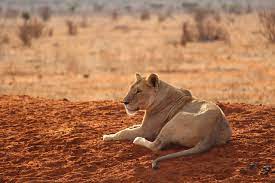Measuring 21,000 square kilometres in size, Tsavo National Park forms the largest wildlife protected area in Kenya. The Nairobi – Mombasa highway splits the park into two, Tsavo East and Tsavo West. The site of dust-red elephants wallowing, rolling and spraying each other with the midnight blue waters of the Galana river is one of the most memorable moments for any visitor to this expansive park that stretches all the way to the boarder with Tanzania.
Tsavo East is the larger of the combined parks and is more popular with safari operators since it offers a pretty sure chance of seeing plenty of animals in a very open environment, just a few hours drive from most coastal hotels. Tsavo East National park is 333km south-east of Nairobi, and 173km north-west of Mombasa. Its relative closeness to the beaches and tourist attarctions around Malindi and Mombasa make it an ideal one-day wildlife safari destination for those who do not want to stay overnight.
Apart from some tumbled cregs and scarps in a few araes, and the rocky Galana River, Tsavo East is uninterrupted plain of bush dotted with crazed shapes of baobab trees. The park is home to most larger mammals as well as a variety of geological features such as Mudanda rock and Lugard falls. Animals include present include,vast herds of dust-red elephant, rhino, buffalo, lion, leopard, pods of hippo, crocodile, waterbucks, lesser kudu, gerenuk and the prolific bird life features over 500 recorded species.
Kenya lies across the equator and Tsavo East National Park is just a few degrees latitude south. The temperature is fairly constant year round but the rainfall varies. The tropical temperature ranges from 27 degrees to 31 degrees celicius in the day and 22-24 degrees celicius at night. The long rainy season last from March to May and the rainfall is heavy, making it a bad time for wildlife safaris. The short rainy season lasts from October to November, but the weather during this period is still good enough to go on safari. The humidity is high from December through April.
Tsavo West National park is more mountanaous and wetter than its counterpart, with swamps, Lake Jipe and the Mzima springs. It is known for birdlife and its large mammals e.g black rhino, cape buffalo, elephant, leopard, hippo and masai lion. There are also other smaller animals that can be spotted in the park, such as the bush baby, hartebeest, lesser kudu and maasai giraffe.

